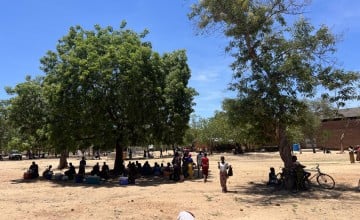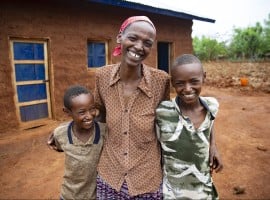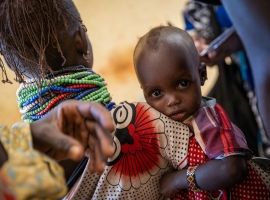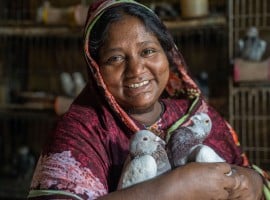
Read our 2024 annual report

Knowledge Hub
Climate Migration
Concern Worldwide works with communities on the frontlines of climate change; those who have lost homes, those at risk of displacement, and those adapting to new realities. We hear stories not just about hardship but also about resilience and renewal.
We work with governments and institutions assessing where support falls short, and where innovative solutions are offering hope. Most importantly, we support communities who are themselves leading the way in rebuilding lives with dignity, security, and opportunity, even in the face of profound change.
Diplaced by Climate: The Rising Tide of Climate Migration
Rising seas, failing crops, and intensifying storms are no longer abstract warnings, they are already forcing millions from their homes. Across the world, people are moving not by choice, but by necessity, as their environments become too dangerous or barren to sustain life. This phenomenon, known as climate migration, is emerging as one of the most urgent human challenges of the century.
The Intergovernmental Panel on Climate Change (IPCC) warned as early as 1990 that climate change could reshape human migration more than any other factor. Today, those warnings are unfolding; floods wash away villages, droughts devastate farmlands, and coastal communities gradually fall into the sea. The Institute for Economics and Peace now estimates that by 2050, as many as 1.2 billion people could be displaced worldwide by environmental disruption and climate-related disasters.
Legal Frameworks
Despite increasing displacement, no clear legal framework exists to protect those forced to move by climate change. Terms including ‘climate migrant’ and ‘climate refugee’ are widely used but lack universally accepted definitions, creating challenges for recognition and support.
Under international law, the 1951 Refugee Convention defines a refugee as someone fleeing persecution based on race, religion, nationality, political opinion, or membership of a particular social group,and one who has crossed an international border. Displacement caused by climate-related factors such as floods, droughts, or sea-level rise do not fall under this definition. Most climate-displaced people remain within their countries and are classified as internally displaced persons (IDPs); a descriptive category with no special rights under international law.
This legal gap leaves millions of people vulnerable. While some climate-displaced individuals’ cross borders, the lack of recognition and formal data makes it difficult to fully understand the scale of international climate migration or to create protective frameworks.
Efforts to address this issue include the Nansen Initiative (2012), the New York Declaration for Refugees and Migrants (2016), and the Global Compact for Safe, Orderly and Regular Migration (2018), which acknowledges climate-induced displacement under Objective 2 by focusing on minimizing the adverse drivers and structural factors that compel people to leave their country of origin. COP24 and COP25 (UNFCCC Climate Negotiations) further highlighted links between land degradation, food insecurity, and forced migration. Yet these milestones remain largely declaratory. The international community has not yet created enforceable rights for climate-displaced people, leaving legal recognition and protection as urgent, unresolved challenges.
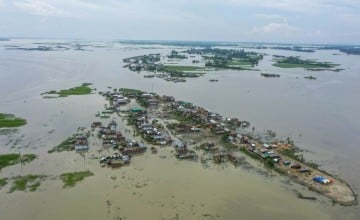
Push and Pull Factors
Migration, whether climate-driven or otherwise, is often shaped by push and pull factors. In the context of climate change, push factors including drought, flooding, rising seas, desertification, or destroyed livelihoods, force people from their homes. Pull factors including jobs, safer environments, education, or family connections, draw people toward new destinations. The balance of these pressures varies widely, creating diverse migration experiences.
Some migration is a matter of survival. When farms fail or storms devastate communities, families have little choice but to relocate. In other cases, migration is pre-emptive, voluntary decisions made to avoid future risks or to pursue better opportunities.
- Analysts highlight several dimensions of climate-related mobility:
- Forced vs. voluntary: Some leave only, when necessary, others move proactively.
- Internal vs. international: Many remain within their countries, while others cross borders, facing greater legal and social hurdles.
- Individual vs. collective: Displacement can affect single households or entire communities. Individuals may leave to find better opportunities, while in other examples, entire communities are required or forced to relocate.
- Sudden vs. slow-onset migration: Some communities leave overnight prior to or after hurricanes or floods, others gradually as sea-level rise or declining crops erode livelihoods.
These distinctions demonstrate that climate migration is not uniform. For some, movement brings safety and opportunity; for others, it is a last resort.
The Lived Reality of Loss and Damage
Migration is not only about moving. It involves losing homes, livelihoods, culture, and identity.
Economic loss and damage is often most visible: families lose farmland, homes, and fishing grounds, leaving them without means of earning a living and creating cycles of poverty in new locations. Receiving communities may also face added pressure on infrastructure, jobs, and services.
Non-economic loss and damage is profound and often overlooked. These include cultural heritage, community ties, ancestral land, and traditional knowledge, particularly for Indigenous communities and small island nations. Displacement can erode identity itself, as people leave sacred spaces, lose languages, and abandon customs tied to place.
Addressing climate migration requires more than economic aid or relocation plans. Responses must recognise human loss and damage, preserve dignity and cultural identity, and allow communities to shape their futures, or we risk treating people as statistics rather than human beings navigating profound upheaval.
Concern Worldwide's Response
As part of the Zurich Climate Resilience Alliance (ZCRA), Concern is currently working with rural and urban communities in Bangladesh, Kenya, Malawi and Pakistan to strengthen their resilience to climate hazards and prevent the need to relocate. We believe that the only way to increase community resilience at scale is to take a systems approach; one that recognizes the wider spectrum of climate challenges that must be addressed.
The work we do in each country as part of the ZCRA, varies depending on the nature of the existing levels of climate resilience, the nature of the climate hazard(s) and local and national policy environments.
For example, in Malawi, the ZCRA is supporting resilience building efforts. Following the devastating effects of Cyclone Ana in 2021, Concern’s Build Back Better approach works with communities to rebuild disaster-resilient homes that can withstand future disasters. By prioritising awareness and skills development, the intervention ensures long term sustainability, scalability and resilience.
